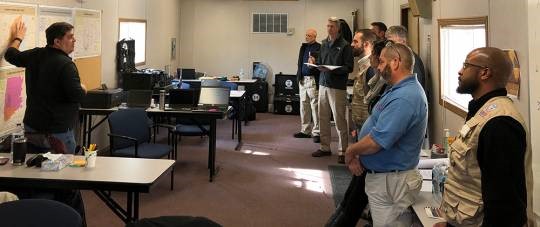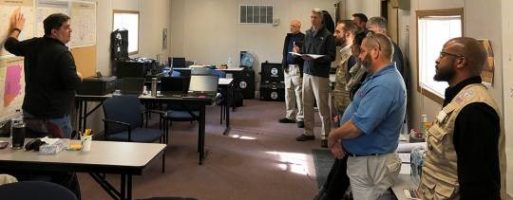
Elements of this article were originally published by DOE/NNSA.
https://nnsa.energy.gov/blog/nnsa-conducts-first-disaster-response-drill-usaid
Kicking off 2018, EMSI aided the Department of Energy’s (DOE) National Nuclear Security Administration (NNSA) with their interagency partners at the United States Agency for International Development’s (USAID) Office of Foreign Disaster Assistance (OFDA) to conduct a field drill, called Concrete Shield.
Recognizing the advantages that each agency brings to a response, this exercise allowed the participants an opportunity to practice using their unique expertise and tools that would be deployed in response to a domestic or international radiological or nuclear incident. Exercising through the use of realistic scenarios helps each agency to maintain mission-readiness in a fault-free environment while additionally allowing agencies to share their capabilities with partners and identifying best practices and lessons learned to improve future response operations.
Using a simulated natural disaster and nuclear incident scenario, NNSA provided radiological experts to integrate their knowledge and tools into the existing OFDA’s Disaster Assistance Response Team (DART) processes. During an international event, NNSA personnel would deploy and embed with DART, which supports requests for U.S. humanitarian assistance by overwhelmed host nations. The team works to ensure that delivery of food, water, shelter, and other life-saving commodities are initiated quickly and that programs to help the affected populations recover begin as soon as possible following a disaster. This need for integrating NNSA radiological expertise into the DART was identified during the response to the earthquake and tsunami, and resulting nuclear accident, in Japan in 2011 where NNSA and OFDA worked closely to provide humanitarian and technical assistance to the Government of Japan.
Humanitarian assistance and disaster relief work is a challenging mission by itself. During a radiological or nuclear incident, NNSA would keep the DART and its partners safe while they conducted wide-scale humanitarian assistance and disaster relief efforts in a potentially contaminated environment. By understanding these additional threats to responders, NNSA helps with those decisions that are complicated by the presence of radiation.
“NNSA’s consequence management experts would join the DART and provide atmospheric dispersion modeling, environmental monitoring and sampling, dose assessment, worker safety, and technical advice and recommendations,” said Dr. Dan Blumenthal, manager for NNSA’s Consequence Management program. “Our deployed experts at the incident site would request additional reach-back support from NNSA national laboratories.”
The Concrete Shield exercise is part of a continuing series of preparedness activities that NNSA and OFDA are conducting to enhance their joint operations in the event of an international radiological or nuclear incident. Future events may expand the exercise to train additional personnel and deploy to an international location to provide a more realistic training environment for the team.
The EMSI lead planner was Dr. Wendy Renno, a nationally recognized expert in radiological response. “The exercise was an overwhelming success,” said Dr. Steve Musolino, an NNSA Radiological Assistance Program team scientist and DART asset project manager. “Role-playing added a dimension of realism to the exercise that allowed our in-field and home teams to employ a comprehensive technical and strategic response effort.”
EMSI has provided emergency management contract support to DOE since 2007 and currently works with several DOE programs. EMSI’s vast experience in complex incident management and hazardous materials response has helped inform some of the advanced incident management approaches to Chemical, Biological, Radiological, and Nuclear (CBRN) incident management. EMSI personnel have been involved in the management of several complex hazardous materials incidents, including the Fukushima Daiichi Nuclear Disaster in 2011. EMSI Vice President of Operations Billy Haley responded to Japan with DOE as part of the U.S. Government’s response to the Fukushima Daiichi Nuclear Disaster. For his contributions, Billy earned the DOE Secretarial Honor Award and the USAID Meritorious Group Award.
EMSI is a service disable veteran owned (SDVOSB), minority business enterprise (MBE) that supports a broad range of clients. To learn more about EMSI and how we can help your organization’s response preparedness, please visit www.emsics.com.


